Indonesia: Slaughter Steers AUD $3.88/kg liveweight (Rp 10,300 = $1AUD)
Prices of slaughter cattle remain weak with further discounting by some feedlots down to Rp38,000 per kg including extended credit terms. Despite these incentives, demand for slaughter cattle remains very disappointing with slow outflows from feedlots continuing the trend of excessive numbers of long-fed and over fat cattle in many feedlots.
The rapidly weakening AUD$ is about the only good news this month although the Rupiah has tended to follow the Aussie$ rather than the USD so the apparent currency improvement for the AUD doesn’t translate to the same advantage for Indonesian importers.
This continuing price weakness is a further clear demonstration that importers cannot afford to pay the current asking prices for live cattle from Australia. This situation is once again totally different from past years when importers carried the losses from high wet season prices because they knew that rates would decline when the dry season started next year and they would pick up their losses.
2017 has been a year of disruption at all stages of the trade and this is continuing with the new wet season market conditions being totally different to previous years. If the traders in northern Australia are wondering how high they can put their prices up this wet season then they should think again. High rates will lead to those cattle remaining unsold by the beginning of next year with the associated losses that implies.
As further evidence of the extremely weak market, exporters are happy to keep their ships moving by taking on large numbers of consignees (up to 5) in a single shipment. This means a lot more work and complexity for every shipment but at least it allows another ship to sail away.
Indian Buffalo import permits
The most important news to come out of Indonesia this month was a statement in the national press by the Ministry of Agriculture on the 15th of November that they had decided to not issue any new recommendation letters for future Indian beef imports.
The Ministry of Ag needs to provide this recommendation to the Ministry of Trade which then provides the import permit. The Director General of Livestock Services advised that the new policy was because the importation of “buffalo meat has not been successful in stabilizing the price of beef in Indonesia and that the Ministry would like to increase Indonesia’s beef production.”
While this is good news for the local livestock industry there are a few qualifications. Firstly, there could be as much as 20,000 tons of frozen product still in Indonesian cold stores. There are also some of the original import permits issued last year that have not been utilized so it may be possible to import a further 30,000 tons remaining on the existing permit before it expires on the 31st of December 2017.
And, of course, government policy can change quickly so while this announcement is very encouraging, its immediate and medium term affects are negligible. Even if the government sticks with this policy it could take as long as six months or more for the last of the buffalo product to work its way through the system so there will be no opportunity for a quick turnaround in slaughter cattle prices for quite a while yet. And all this does not take into account smuggled Indian product which is reported to be entering the country in large volumes.
Buffalo meat in Brunei
I took the photo below in a Brunei supermarket last week. Brunei has some of the highest prices for food anywhere in the world but their prices for frozen Indian buffalo are about the same as those in Indonesia, further highlighting the failure of the Indonesian policy to pass the low prices of buffalo product on to the consumer. Frozen Indian buffalo beef in Malaysian wet markets sells for Rp73,000 per kg.
$8.50 per kg Brunei translates to about Rp88,400 per kg which is similar or below many outlets in Indonesia.
1 to 5 breeding cattle policy
The 1 for 5 breeding cattle policy is also still hanging over the heads of the importers while the government decides how to deal with the reality that virtually nobody has complied with their signed agreements.
The fact that the government has reviewed the buffalo meat policy might give importers some hope that the bureaucrats are able to identify a bad policy once they have had long enough to look at it so I am sure everyone has their fingers crossed. If the buffalo imports stop but the 1 for 5 policy remains then importers are still heading for bankruptcy so it is critical that the government puts and end to this impossible policy too.
While the live trade and wet markets are tangled up in a bureaucratic nightmare, the high-end beef business is booming with sophisticated retail beef outlets springing up all over Indonesia. I took these photos in one magnificent beef outlet in Pantai Indah Kapuk which is a fast growing residential suburb located near the Jakarta airport.
High quality beef from all over the world available to take home or eat in the restaurant.
Lots of educational information to ensure your eating experience is a good one.
A wide selection of top notch beef which is sold per 100 grams with the chef cutting to your specific order. And I can confirm that they cook it perfectly too.
Vietnam: Slaughter Steers AUD $3.87 / kg (VND17,300 to $1AUD)
Demand and prices remain weak across Vietnam. Many feedlots have large numbers of stock ready to sell but buyers are scarce. Pork is providing strong competition with record low prices. To make things worse, in the north, a recent record flood has left farmers with little to feed their cattle with so this market is oversupplied with their forced sales at discounted rates.
In the south, steers at around 500kg are selling from D65-68,000 per kg live weight, Bulls D71-72k and 400kg heifers at D64,000. Prices in the north are about 1-2,000 Dong per kg more expensive.
Northern Australian producers and traders need to understand that the situation in the Vietnam market is similar to the Indonesian market even though the reasons for the weak trade are very different. Importers have their backs to the wall and will only be able to buy Australian cattle if the prices are reduced for the wet season instead of the traditional increase. Disappointing but true.
Thailand: Slaughter Steers AUD $4.00 / kg (Baht 25.0 to $1AUD)
I have reports of a slight strengthening in the Thai domestic market for slaughter steers in November with the current rate sitting on 100Baht per kg. The Baht has gained against the Aussie $ which has pushed the AUD price to $4 this month.
Selected cattle which can demonstrate good carcases and prove nil Beta-agonist use can achieve Bht110 per kg live for export to Vietnam and China.
Very low numbers are being imported from Myanmar which leads Thai traders to speculate that the Chinese importers may have established a safe and direct route into China through northern Myanmar.
The Thai Department of Agriculture (DLD) are currently in negotiations with China to establish a legal pathway for exports of live cattle and beef to move into southern China from certified Thai farms. The potential route for product into China is rumoured to be the new Lao Silk Road rail link with the first completed station expected to be at the tourist town Luang Prabang on the Mekong River in northern Lao.
Malaysia: Slaughter Steers AUD $3.81 per / kg (RM3.15 to $1 AUD)
The Malaysian currency has also picked up as the AUD has declined so the rate this month for live cattle has risen to $3.81 even with steady local live cattle prices.
Malaysian buffalo prices are the equivalent of Rp73,000 in the wet markets.
Philippines: Slaughter Cattle AUD $3.51 / kg (Peso 38.5 to AUD$1)
A combination of the weakening AUD and a significant rise in local cattle prices has led to a spectacular rise in the price of live slaughter cattle in AUD terms. Local prices for slaughter steers rose from Peso120 per kg last month to P135 in November. The Philippines live cattle market has proven to be the best performer during 2017 with movement in the local slaughter cattle prices from P100 in January 2017 to P135 this month or a 35% increase in 11 months.
My agent describes the upbeat situation so well I have provided his direct comments below:
“Here we are with the November report.
Yes, it was a great month. The economy is doing well. Every where we are manufacturing. Things which even 2 or 3 year ago were not AVAILABLE are available now. Goods for the food sector, imported PROCESSED MEATS are now also hitting the selves, cheese, another delicacy which only reached Manila during earlier years is now available in almost every Super Market here in the south. Production in factories is continues. Canned goods, “fish and even vegetables” are being canned and are hitting the Market shelves. On the meat side, Beef as is usually the case goes up in price this time of the year but that artificial. Demand, a lot of demand in a country who has a few million consumers more every year. So there is demand. Strangely or NOT so strangely Hog price has dropped at a time it usually rises. If I compare to 5 years ago, unbelievable to availability of Fruits. We even have KIWI, from the Land of New Zealand. And the prices people are willing and able to pay. In a 3rd world country, we have for example on offer “APPLE” for the price of over a half US Dollar a piece and if you go LATE to the Market is “SOLD OUT”. Remember that after all 6 US Dollar is for millions and millions of people the basic daily wage.
On the government side of things, business as usual on this president. Cracking down on crime. Slashing “over” budgeted budgets.
The “Martial Law, which was so controversial months ago, is still intact until Dec. 31 but it OUT OF THE NEWS. Life goes on , rebuilding of the torn City of Marawi goes on. Military check point , put up during the declaration of Martial law are little by little being dismantled.”
China: Slaughter Cattle AUD $5.03 / kg (RMB 5.03 = AUD$1)
The steady rise in Chinese prices continues this month with the Beijing price up sharply to Y25.3 although the Shanghai rate has slipped back to Y24.
Confirmation of this stronger rate is a similar rise in beef prices especially in Beijing. This month I will use the Beijing price of 25.3 which allows China to once again break through the AUD$5 per kg level for the first time since March 2016.
Wellard has successfully completed its recent trial shipment to China. While the commercial numbers still don’t add up, they are certainly getting closer to a position where the live cattle trade from Australia to China will switch from a “future potential” to a current reality. The impact on the Australian industry will be dramatic. If the domestic price continues with its current trajectory and the AUD to Yuan trend is maintained then we wont have long to wait.
| Month | Beijing Slaughter price | Shanghai |
| March 2017 | 22.5 RMB per kg live | 18 |
| April | 22.5 | 19.2 |
| May | 22.5 | 20 |
| June | 21.5 | 22 |
| July | 23.2 | 23 |
| August | 24 | 24 |
| September | 24 | 24 |
| October 2017 | 24.4 | 24.7 |
| November 17 | 25.3 | 24 |
Aussie beef in Saudi Arabia
Dr James Fortune who is based in the Saudi capital of Riyadh kindly sent these photos of some Australian product presented in their supermarkets.
Dubai Wet Market
George Black recently visited Dubai and sent these photos of their “wet” market which must be the smartest anywhere in the world.
Market price table for November 2017
(All prices converted to AUD)
These figures are converted to AUD$ from their respective currencies which are changing every day so the actual prices here are corrupted slightly by constant foreign exchange fluctuations. The AUD$ figures presented below should be regarded as reliable trends rather than exact individual prices. Where possible the meat cut used for pricing in the wet and supermarket is Knuckle / Round.
| Location | Date | Wet Market
AUD$/kg |
Super market
$/kg |
Broiler chicken
$/kg |
Live Steer
Slaughter Wt AUD$/kg |
| Indonesia | June 17 | 13.83 | 19.95 | 3.95 | 3.95 |
| Rp10,400 | July 17 | 12.50 | 14.71 | 3.84 | 3.85 |
| Rp10,575 | August 17 | 12.29 | 14.47 | 3.50 | 3.78 |
| Rp10,600 | Sept 17 | 12.26 | 19.05 | 3.25 | 3.77 |
| Rp10,500 | October 17 | 12.57 | 19.23 | 3.33 | 3.81 |
| Rp10,300 | Nov 17 | 12.82 | 19.61 | 3.30 | 3.88 |
| Philippines | June 17 | 8.22 | 8.49 | 3.66 | 2.92 |
| P39.5 | July 17 | 7.85 | 8.10 | 3.54 | 2.78 |
| P40.5 | August 17 | 7.40 | 7.40 | 3.46 | 2.72 |
| P40.5 | Sept 17 | 7.41 | 7.53 | 3.28 | 2.96 |
| P39.9 | October 17 | 7.69 | 7.64 | 3.46 | 3.01 |
| P38.5 | Nov 17 | 8.05 | 7.92 | 2.99 | 3.51 |
| Thailand | June 17 | 9.34 | 10.89 | 2.72 | 3.89 |
| THB 26.3 | July 17 | 9.12 | 10.65 | 2.66 | 3.80 |
| THB 26.3 | August 17 | 9.12 | 10.65 | 2.66 | 3.80 |
| THB 26.3 | Sept 17 | 9.13 | 10.65 | 2.66 | 3.72 |
| THB 25.7 | October 17 | 9.34 | 10.89 | 2.72 | 3.81 |
| THB 25.0 | Nov 17 | 9.60 | 11.20 | 2.80 | 4.00 |
| Malaysia | June 17 | 9.85 6.77 | 2.30 | 3.63 | |
| MYR 3.35 | July 17 | 9.55 6.57 | 10.15 | 2.53 | 3.52 |
| MYR 3.39 | August 17 | 9.44 6.49 | 10.03 | 2.51 | 3.54 |
| MYR 3.33 | Sept 17 | 9.60 6.60 | 10.21 | 2.34 | 3.60 |
| MYR 3.28 | October 17 | 9.76 6.71 | 10.36 | 2.07 | 3.66 |
| MYR 3.15 | Nov 17 | 10.15 7.30 | 11.75 | 2.29 | 3.81 |
| Vietnam HCM | June 17 | 14.49 | 17.50 | 6.96 | 3.94 |
| D17,800 | July 17 | 14.04 | 16.97 | 6.74 | 3.82 |
| D17,950 | August 17 | 13.93 | 15.60 | 5.57 | 3.79 |
| D18,000 | Sept 17 | 13.89 | 15.55 | 6.94 | 3.77 |
| D17,600 | October 17 | 14.20 | 13.92 | 7.22 | 3.81 |
| D17,300 | Nov 17 | 17.92 | 14.16 | 7.51 | 3.87 |
| China Beijing | June 17 | 12.01 | 14.73 | 3.68 | 4.17 |
| Y5.3 | July 17 | 11.70 | 14.72 | 3.58 | 4.38 |
| Y5.25 | August 17 | 11.62 | 14.48 | 3.61 | 4.57 |
| Y5.23 | Sept 17 | 11.85 | 14.53 | 3.63 | 4.59 |
| Y5.14 | October 17 | 12.45 | 15.18 | 3.69 | 4.75 |
| Y5.03 | Nov 17 | 13.52 | 15.90 | 3.78 | 5.03 |
| Shanghai | May 17 | 14.14 | 19.25 | 4.40 | 3.93 |
| June 17 | 14.34 | 18.99 | 4.65 | 4.26 | |
| July 17 | 13.58 | 17.74 | 4.53 | 4.34 | |
| August 17 | 15.04 | 18.66 | 4.95 | 4.57 | |
| Sept 17 | 15.29 | 18.44 | 4.78 | 4.59 | |
| October 17 | 15.95 | 19.07 | 4.86 | 4.75 | |
| Nov 17 | 16.70 | 19.48 | 4.97 | 4.77 |


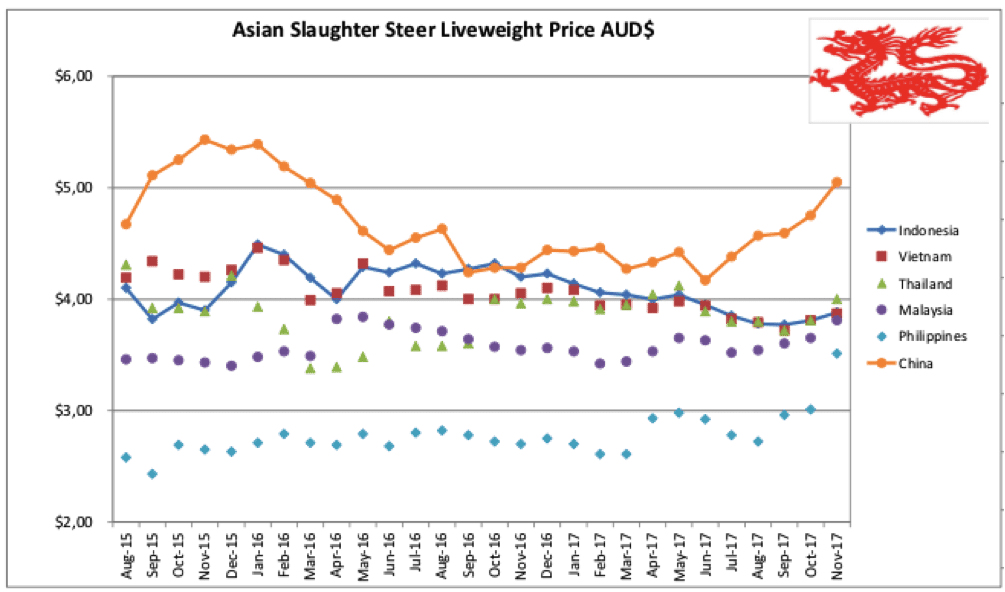
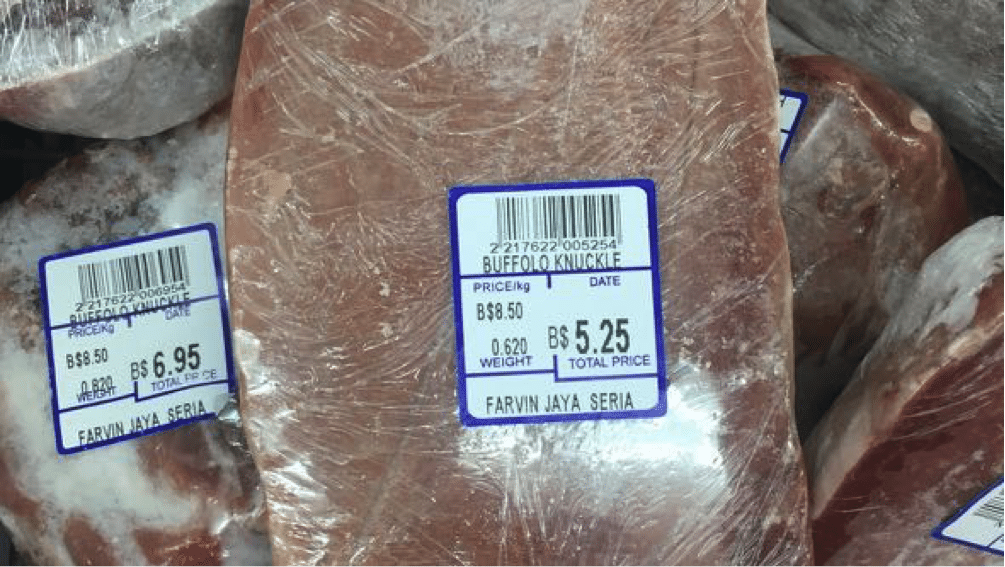
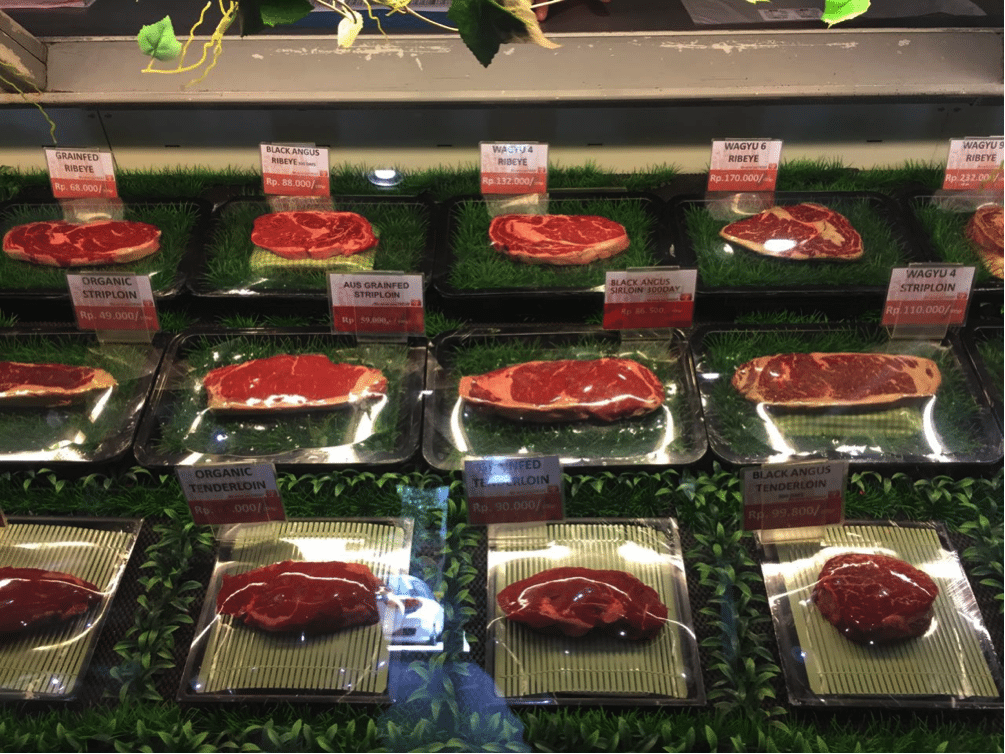
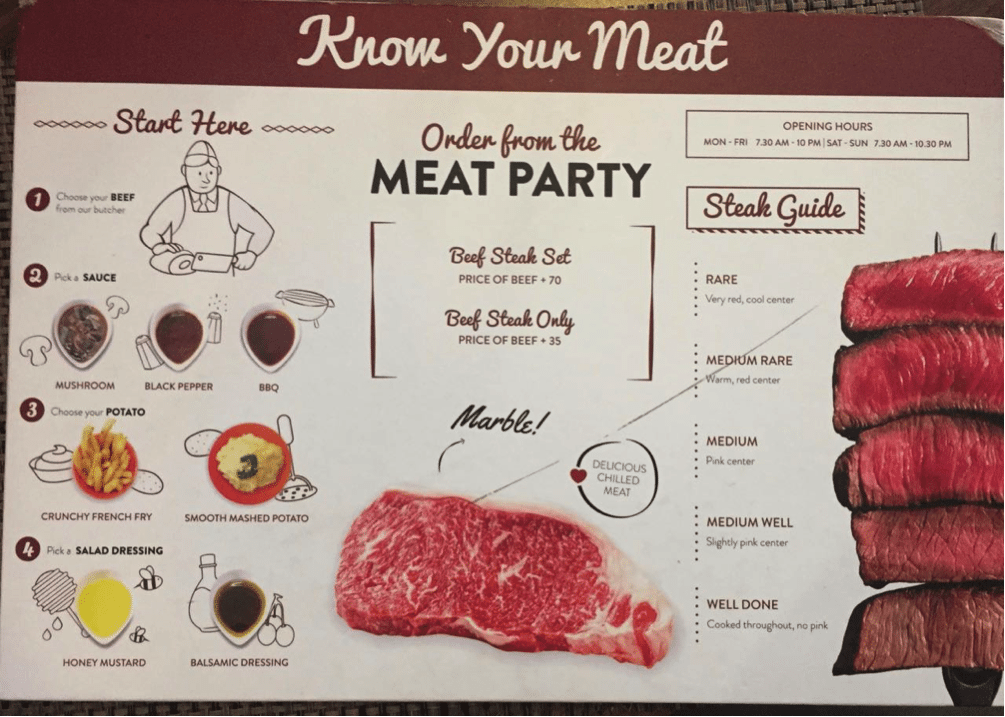
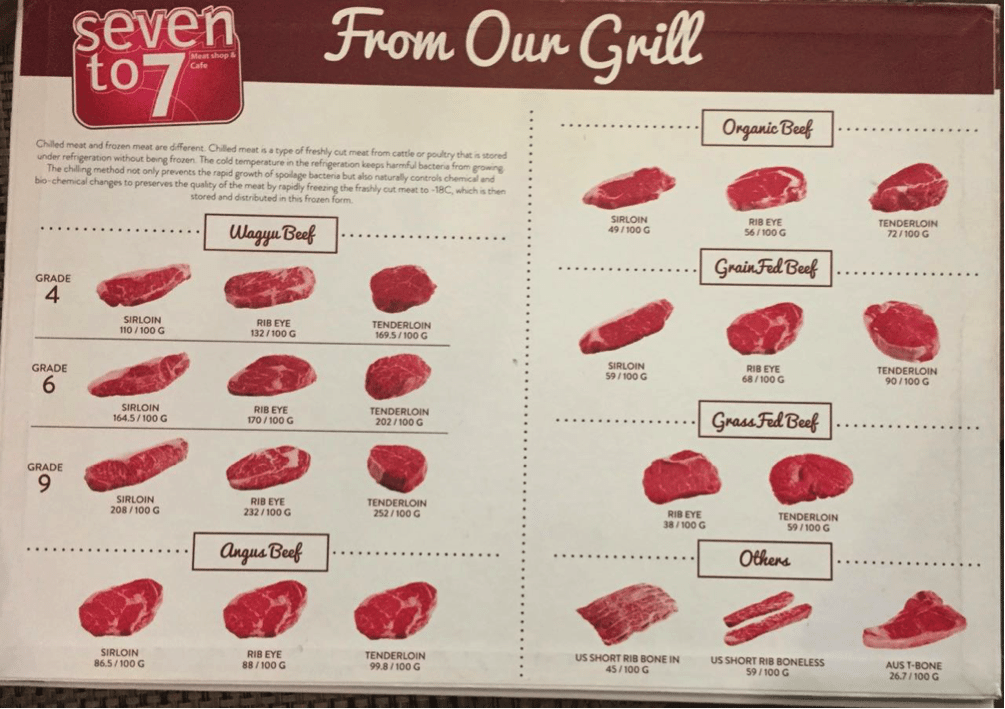
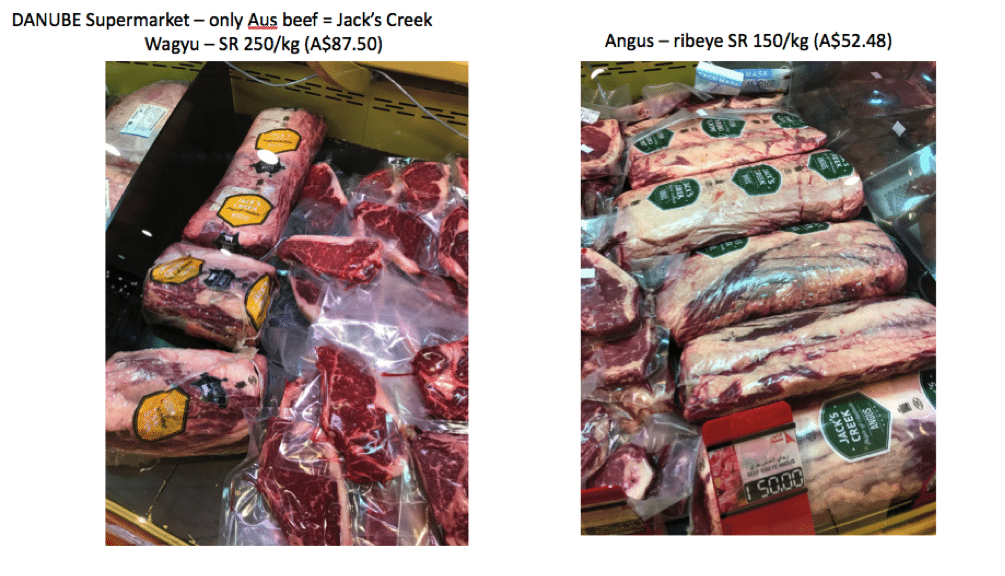
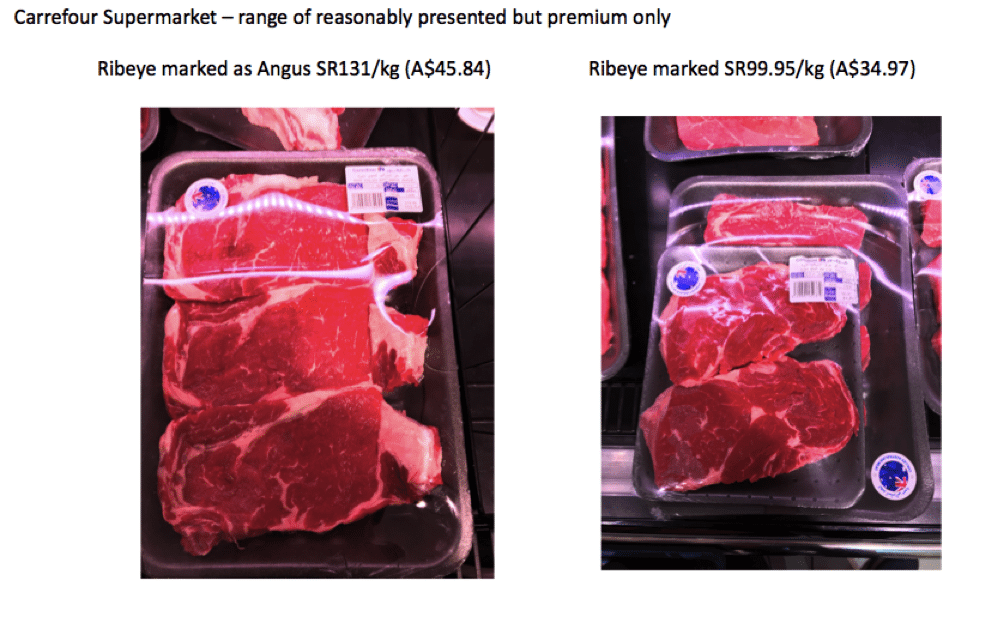
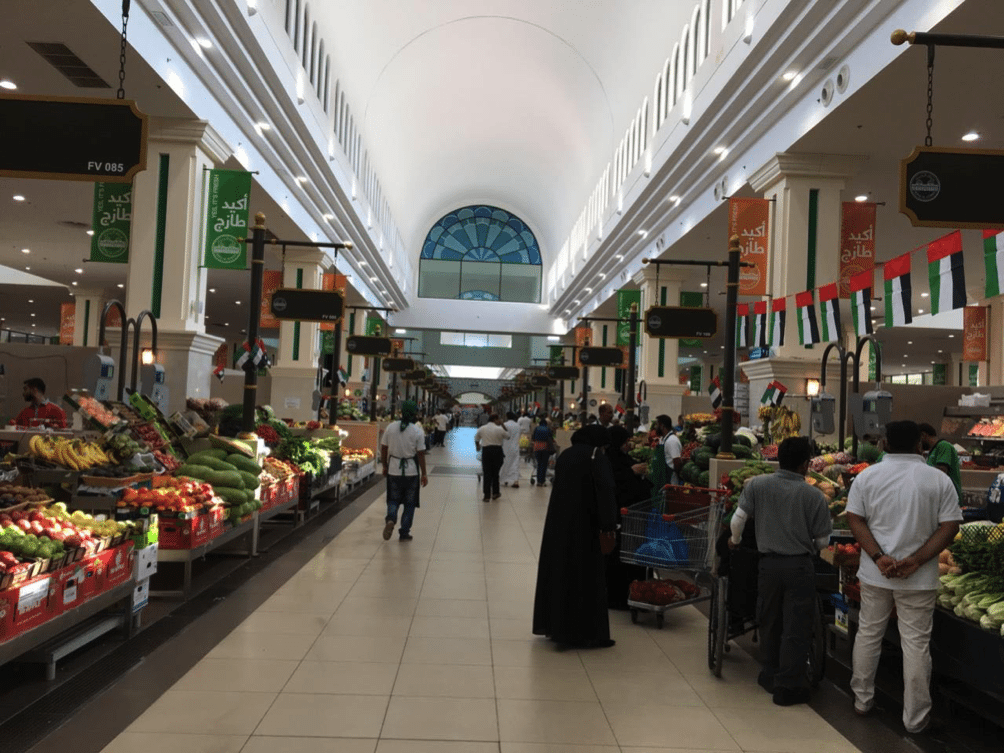
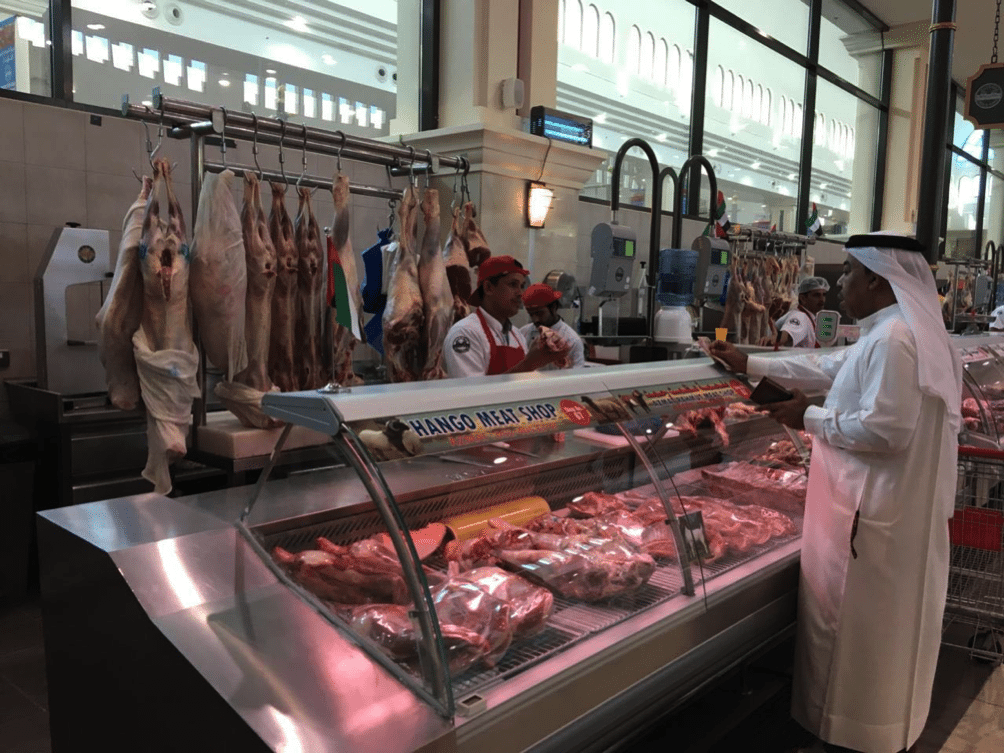
There are positives in this market report for Northern Australian cattle producers. Could not find grass fed steak in the Indonesian display. I assume the other cuts were frozen. Maybe there could be a renewed interest in importing ‘process ready’ cattle from Australia which would not impact on local producer prices for ‘process ready ‘ cattle ??